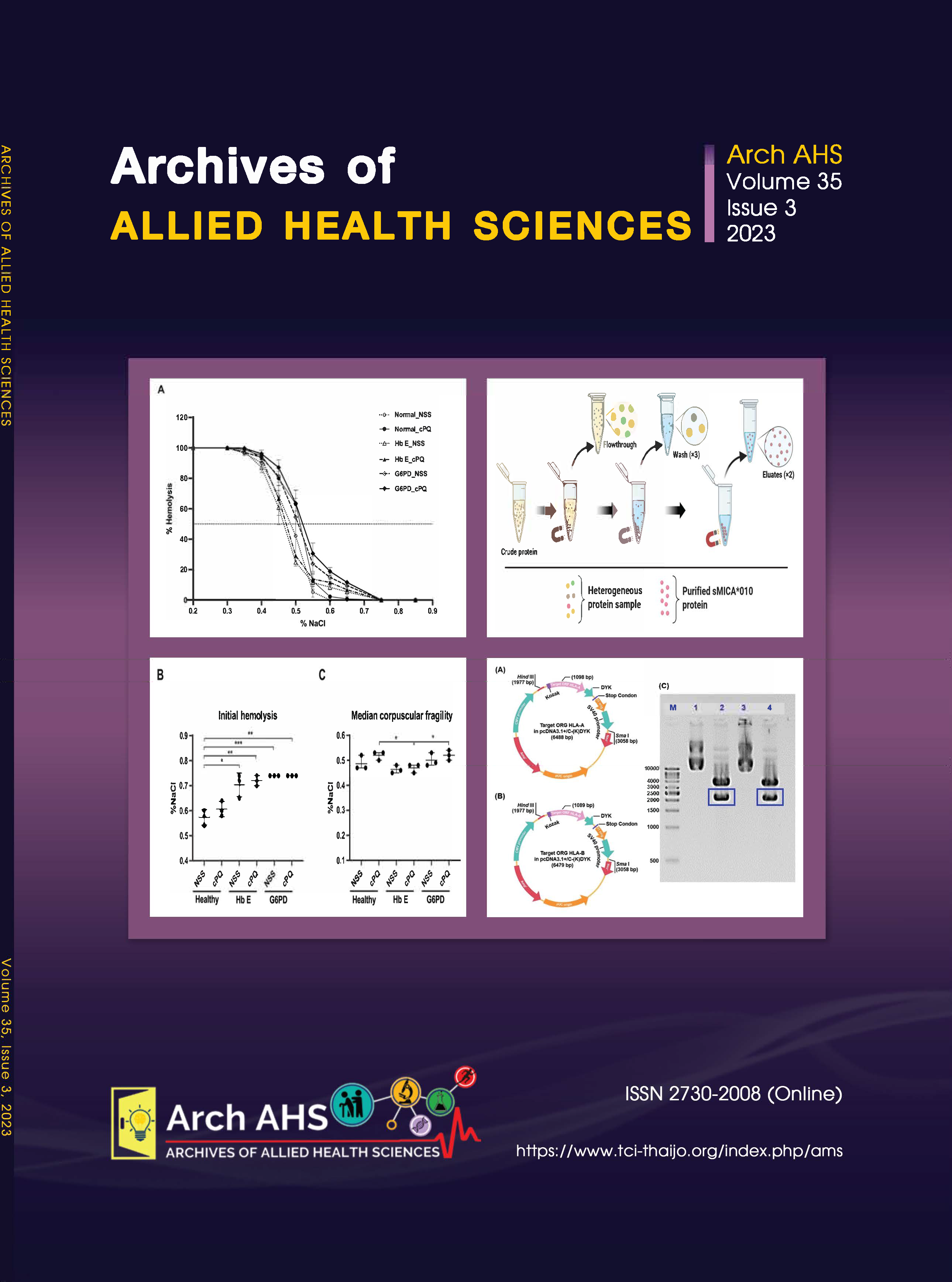Improved purification protocol for recombinant human leukocyte antigens using an affinity magnetic agarose
Main Article Content
Abstract
Anti-human leukocyte antigen (HLA) antibodies are a risk factor for graft failure and graft loss in organ transplantation. To develop a new biomolecular technique for anti-HLA antibody detection against HLA antigens, a large quantity of HLA proteins is necessary. The optimization of existing protein purification protocols plays a crucial role in laboratory practice in biomolecular technology. In this work, we presented the efficient expression of recombinant HLA-A and -B proteins in the HEK 293T cell line and an improved protocol of the PierceTM anti-DYKDDDDK magnetic agarose method for HLA protein purification to enhance the quantity of proteins. The percent recoveries of HLA-A and -B proteins were 81.15% and 80.73% at 350–380 μg/mL in the total eluates, respectively. The number of elution times and incubation time in the elution step were the most important to enhance the percent recovery and quantity of purified proteins. In conclusion, the improved purification protocol enables the high-yield production of functional recombinant HLA-A and -B proteins for the establishment of an ion-sensitive field-effect transistor-based immunosensor for anti-HLA antibody detection. Moreover, it could provide a useful guideline for the expression and purification of other DYKDDDDK-tagged recombinant proteins.
Article Details

This work is licensed under a Creative Commons Attribution-NonCommercial-NoDerivatives 4.0 International License.
References
Klein JAN, Sato A. The HLA system: First of two parts. N Engl J Med 2000; 343(10): 702–9.
Williams TM. Human leukocyte antigen gene polymorphism and the histocompatibility laboratory. J Mol Diagn 2001; 3(3): 98–104.
Puttarajappa C, Shapiro R, Tan HP. Antibody-Mediated Rejection in Kidney Transplantation: A Review. J Transplant 2012; 2012: 1–9.
Lefaucheur C, Loupy A, Hill GS, Andrade J, Nochy D, Antoine C, et al. Preexisting donor-specific HLA antibodies predict outcome in kidney transplantation. J Am Soc Nephrol 2010; 21(8): 1398–407.
Roux A, Bendib Le Lan I, Holifanjaniaina S, Thomas KA, Hamid AM, Picard C, et al. Antibody-Mediated Rejection in Lung Transplantation: Clinical Outcomes and Donor-Specific Antibody Characteristics. Am J Transplant 2016; 16(4): 1216–28.
Zhang J, Qi L, Zheng WT, Tian Y Le, Chi AP, Zhang ZQ. Novel functionalized poly(glycidyl methacrylate-co-ethylene dimethacrylate) microspheres for the solid-phase extraction of glycopeptides/glycoproteins. J Sep Sci 2017; 40(5): 1107–14.
Ma Y, Chen T, Iqbal MZ, Yang F, Hampp N, Wu A, et al. Applications of magnetic materials separation in biological nanomedicine. Electrophoresis 2019; 40(16): 2011–28.
Thekkilaveedu S, Krishnaswami V, Mohanan DP, Alagarsamy S, Natesan S, Kandasamy R. Lactic acid-mediated isolation of alpha-, beta- and kappa-casein fractions by isoelectric precipitation coupled with cold extraction from defatted cow milk. Int J Dairy Technol 2020; 73(1): 31–9.
Dias AMGC, Hussain A, Marcos AS, Roque ACA. A biotechnological perspective on the application of iron oxide magnetic colloids modified with polysaccharides. Biotechnol Adv 2011; 29(1):142–55.
Borlido L, Azevedo AM, Roque ACA, Aires- Barros MR. Magnetic separations in biotechnology. Biotechnol Adv 2013; 31(8):1 374–85.
Liu S, Yu B, Wang S, Shen Y, Cong H. Preparation, surface functionalization and application of Fe3O4 magnetic nanoparticles. Adv Colloid Interface Sci 2020; 281: 102165.
Roche Diagrnostics. X-tremeGENE HP DNA Transfection Reagent [online] 2020 [cited 2023 April 27] Available from https://www. sigmaaldrich.com/deepweb/assets/ sigmaaldrich/product/ documents/234/408/ xtghp-ro.pdf
A CN. Pierce TM Anti-DYKDDDDK Magnetic Agarose [online] 2017 [cited 2023 April 27] Available from https://assets.fishersci.com/ T F S - A s s e t s / L S G / m a n u a l s / MAN0017395_2162708_Pi e rceAn t i _ DYKDDDDK_MagAgarose_PI.pdf
Antibody DT. GenEZ TM ORF clone User manual [online] 2015 [cited 2023 April 27] Availabel from https://www.genscript.com/gsfiles/ User%20manual_GenEZ%20ORF% 20Clone%20 Products.pdf
Moore DD. Current Protocol in Molecular Biology. In: Ausubel FM, Brent R, Kingston RE, Moore DD, Seidman JG, Smith JA, Struhl K, editors. New Jersey: John Wiley & Sons, Inc; 2006. p. 4412–35.
Halff EF, Versteeg M, Brondijk THC, Huizinga EG. When less becomes more: Optimization of protein expression in HEK293-EBNA1 cells using plasmid titration - A case study for NLRs. Protein Expr Purif 2014; 99: 27–34.
Melville M, Estes S. Mammalian Cell Line Developments in Speed and Efficiency. Adv Biochem Eng Biotechnol 2013; 123(July 2015): 127–41.
DuBridge RB, Tang P, Hsia HC, Leong PM, Miller JH, Calos MP. Analysis of mutation in human cells by using an Epstein-Barr virus shuttle system. Mol Cell Biol 1987; 7(1): 379–87.
Pina AS, Lowe CR, Roque ACA. Challenges and o p p o r t u n i t i e s i n t h e p u r i fi c a t i o n o f recombinant tagged proteins. Biotechnol Adv 2014; 32(2): 366–81.
Nilsson J, Ståhl S, Lundeberg J, Uhlén M, Nygren PÅ. Affinity fusion strategies for detection, purification, and immobilization of recombinant proteins. Protein Expr Purif 1997; 11(1): 1–16.
Fritze CE, Anderson TR. Epitope tagging: General method for tracking recombinant proteins. Methods Enzymol 2000; 327(1987): 3–16.
Judge RA, Jacobs RS, Frazier T, Snell EH, Pusey ML. The effect of temperature and solution pH on the nucleation of tetragonal lysozyme crystals. Biophys J 1999; 77(3): 1585–93.
Alberti S, Saha S, Woodruff JB, Franzmann TM, Wang J, Hyman AA. A User’s Guide for Phase Separation Assays with Purified Proteins. J Mol Biol 2018; 430(23): 4806–20.
Min TZMMM, Phanabamrung S, Chaisriratanakul W, Pankiew A, Srisuwan A, Chauyrod K, et al. Biosensors Based on Ion-Sensitive Field-Effect Transistors for HLA and MICA Antibody Detection in Kidney Transplantation. Molecules 2022; 27(19): 1–18.


